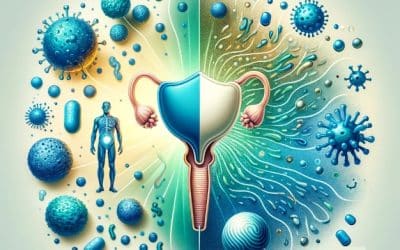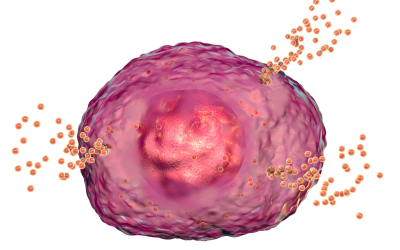Exposure to toxins may have detrimental effects on humans and animals, even at low concentrations. Specific probiotic and bacterial strains may have properties that enable them to bind to toxins we are exposed to in our environment, such as food and water. Different strains vary in their ability to bind and detoxify, often times relying on pH, contact time, and viability on the binding capacities. Below are 3 bacterial strains and a summary of their mechanisms of action on human biochemistry regarding detoxification.
Mycotoxin Degradation – Mycotoxins are secondary metabolites produced by fungi, and are capable of producing disease and death in humans (Chlebicz & Slizewska, 2019). Humans are exposed to mycotoxins while consuming plant foods such as nuts (hazelnut, almonds, pistachios), peanuts, grains and some fruits. They are also exposed to them in the environment such as often reported in mold that is found in homes that have been water damaged. Aflatoxins are secondary metabolites of Aspergillus flavus and Aspergillus parasiticus, and it has been estimated that 4.5 billion of the world’s population is exposed to aflatoxins (Wild & Gong, 2010). The aflatoxins occur mostly in tropical regions with high humidity and temperature. They accumulate post-harvest when food commodities are stored under conditions that promote fungal growth. The naturally occurring aflatoxins are AFB1, AFB2, AFG1 and AFG2, with AFB1 the most abundant, toxic and carcinogenic, and are linked to liver cancer. “However, in agriculture, other adverse effects, including toxicity, growth and immune impairment, have been widely reported and these end points are rightly of increasing focus in studies of exposed people” (Wild & Gong, 2010).
Aflatoxin B1 (AFB1) is considered to possess the highest toxicity among various types of secondary metabolites produced by a larger number of Aspergillus spp., and classified as a Group I carcinogen for humans by the International Agency for Research on Cancer (Chlebicz & Slizewska, 2019). It has been reported that AFB1 could induce growth retardation, liver cancer, and may suppress immunity. Relevant studies indicated that AFB1was mostly metabolized by cytochrome P450 (CYP 450) enzyme systems after being absorbed in the GI tract. “Subsequently, under the action of CYP 450, including CYP1A2 and CYP 3A4, AFB1 was transformed to exo-AFB1-8,9-epoxide (AFBO), which could bind to DNA, proteins, and other critical cellular macromolecules to exert its carcinogenic effect” (Chlebicz & Slizewska, 2019).
Below are two probiotics that show promise in detoxification of mycotoxins:
- Saccharomyces cerevisiae var boulardii- (note the authors indicate that since S. cerevisiae and S. boulardii are closely similar in molecular structure, they should not be viewed as separate species taxonomically, so they have been renamed as saccharomyces cerevisiae van boulardii). Inhibition of mycotoxin absorption in the GI tract is one of the mechanisms of action of this strain. The mechanism of detoxification by yeast is due to the adhesion of mycotoxins to cell-wall components. In addition, this strain can biodegrade mycotoxins (such as AFB1) to prevent adsorption of these components inside the intestines on those who consume the food that is contaminated with the aflatoxin. As a side note, Saccharomyces cerevisiae var boulardii can also degrade phytates that are also found on many of the same foods that mycotoxins are found, and this may improve adsorption of iron, zinc, magnesium and phosphorus binding (Moslehi-Jenabian, Pedersen, & Jespersen, 2010). This could be viewed as a secondary mechanism involved in detoxification.
- L. plantarum—Lactobacillus species are also able to bind mycotoxins. Via hydrophobic interactions, they are able to bind to mostly cell wall peptidoglycans, polysaccharides and teichoic acid (Chlebicz & Slizewska, 2019). L. plantarum has demonstrated to have good AFB1binding ability in vitro. It can also “increase fecal AFB1excretion, reduce lipid peroxidation, and reverse antioxidant defense systems to alleviate AFB1 toxicity” (Chlebicz & Slizewska, 2019). L. plantarum may also play a role in the suppression of CYP1A2 and CYP3A4 expression to enhance glutathione-conjugating activity and promote detoxification (Chlebicz & Slizewska, 2019). It has been reported that some lactic acid bacteria such as L. plantarum can remove AFB1 or have protective effects against AFB1. Some relevant studies demonstrated that lactobacilli could inhibit the production of aflatoxin as well as the growth of Aspergillus spp. (Huang et al., 2017). L. plantarum also demonstrates strong free radical scavenging activities and can improve antioxidant status, protecting against the effects of AFB1. “L. plantarum might also act as a biological barrier in the intestine under normal conditions, thereby reducing the bioavailability of AFB1 ingested orally and hence avoiding its toxic effects” (Chlebicz & Slizewska, 2019). I attached a chart that demonstrates some of the mechanisms of L. plantarum on detoxification of AFB1., which includes increasing AFB1 excretion, decreasing AFB1 epoxidation catalyzed by CYP1A2 and CYP3A4, coupled with enhancing the activities of different antioxidant enzymes and GST detoxification which are connected with the NrF2 signaling pathway (Chlebicz & Slizewska, 2019).
- Bacillus subtilis– This spore forming species of bacteria had some interesting mechanisms in detoxification.
Pesticides- Cypermethrin
Cypermethrin belongs to a group of synthetic pyrethroid insecticides which widely used in agriculture, forestry, horticulture, public health and households for the protection of textiles and to check pest infestation (Gangola, Sharma, Bhatt, Khati, & Chaudhary, 2018). . Cypermethrin is also constitute common ingredients of household insecticides (Gangola et al., 2018). Cypermethrin is an environment pollutant because of its widespread use and toxicity. Persistence may lead to serious damage to non-target organisms and various ecosystem (Gangola et al., 2018). Metabolism of cypermethrin is important because cypermethrin possess antimicrobial activities hence it prevents the beneficial microflora.
The mechanism of action is the laccase enzyme that can degrade the pesticide. Bacillus subtilis strain demonstrated to completely metabolize cypermethrin in just 15 days under laboratory conditions. The bacterial isolate harbors the metabolic pathway for the detoxification of the cypermethrin. It can also completely degrades cypermethrin without leaving any persistent or toxic metabolite (Gangola et al., 2018).
Heavy metals (Syed & Chinthala, 2015)
It is estimated that over one billion human beings are currently exposed to elevated concentrations of toxic metals and metalloids in the environment. It is also estimated that several million people may be suffering from subclinical metal poisoning. “In addition, adverse effect of heavy metals includes suppression of the immune system and carcinogenicity, neurotoxicity, mainly in children, and inhibition of the activity of some critical enzymes related to synthesis of vital biomolecules along with accumulation in the body of different organisms causing biomagnifications” (Syed & Chinthala, 2015). B. subtilis has greater ability to bind metals than Gram-negative ones due to their different cell wall structures (Cai et al., 2018). Interestingly, bacterial isolates of B. subtilis showed significant biosorption of lead. Heavy metal biosorption is the ability of bacterial cells or components to adsorb, chelate, or precipitate metal ions in the solution into insoluble particles or aggregates which can be removed either by sedimentation or filtration from the solution. Lead biosorption modifies groups like carboxyl, hydroxyl, and amino where other metal ions cannot compete offering it more affinity. The main agents in the uptake of heavy metals by B. subtilis are carboxyl groups, the sources of which are the teichoic acids associated with the peptidoglycan layers of the cell wall (Cai et al., 2018).
References
Cai, Y., Li, X., Liu, D., Xu, C., Ai, Y., Sun, X., . . . Yu, H. (2018). A Novel Pb-Resistant Bacillus subtilis Bacterium Isolate for Co-Biosorption of Hazardous Sb(III) and Pb(II): Thermodynamics and Application Strategy. Int J Environ Res Public Health, 15(4). doi:10.3390/ijerph15040702
Chlebicz, A., & Slizewska, K. (2019). In Vitro Detoxification of Aflatoxin B1, Deoxynivalenol, Fumonisins, T-2 Toxin and Zearalenone by Probiotic Bacteria from Genus Lactobacillus and Saccharomyces cerevisiae Yeast. Probiotics Antimicrob Proteins. doi:10.1007/s12602-018-9512-x
Gangola, S., Sharma, A., Bhatt, P., Khati, P., & Chaudhary, P. (2018). Presence of esterase and laccase in Bacillus subtilis facilitates biodegradation and detoxification of cypermethrin. Sci Rep, 8(1), 12755. doi:10.1038/s41598-018-31082-5
Huang, L., Duan, C., Zhao, Y., Gao, L., Niu, C., Xu, J., & Li, S. (2017). Reduction of Aflatoxin B1 Toxicity by Lactobacillus plantarum C88: A Potential Probiotic Strain Isolated from Chinese Traditional Fermented Food “Tofu”. PLoS ONE, 12(1), e0170109. doi:10.1371/journal.pone.0170109
Moslehi-Jenabian, S., Pedersen, L. L., & Jespersen, L. (2010). Beneficial effects of probiotic and food borne yeasts on human health. Nutrients, 2(4), 449-473. doi:10.3390/nu2040449
Syed, S., & Chinthala, P. (2015). Heavy Metal Detoxification by Different Bacillus Species Isolated from Solar Salterns. Scientifica (Cairo), 2015, 319760. doi:10.1155/2015/319760
Wild, C. P., & Gong, Y. Y. (2010). Mycotoxins and human disease: a largely ignored global health issue. Carcinogenesis, 31(1), 71-82. doi:10.1093/carcin/bgp264







